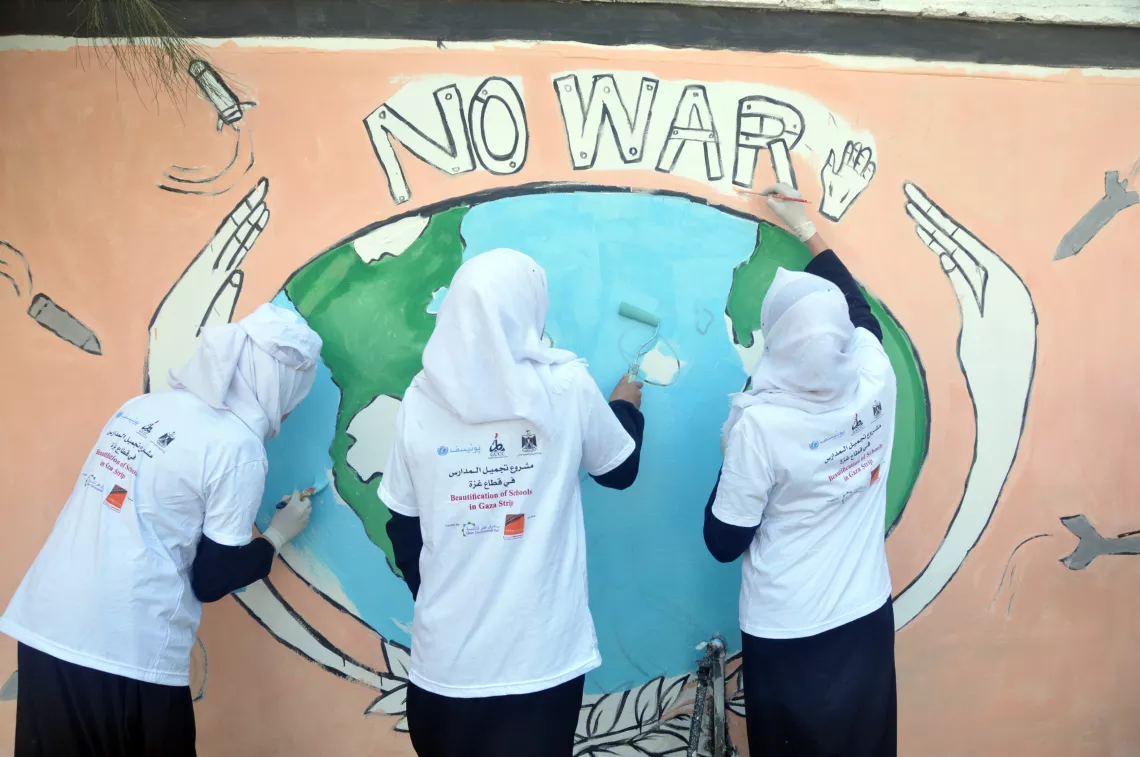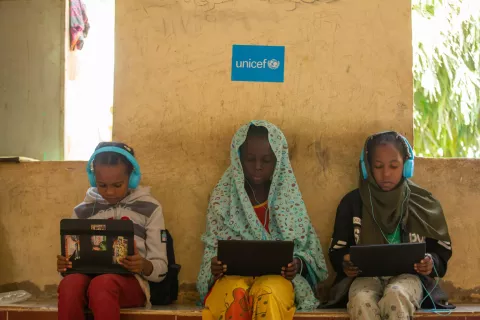Children in Gaza design their dream school
A newly designed child-friendly school takes students’ dreams into account — safer, more inclusive and with greater access

- Available in:
- English
- Français
Across the Gaza Strip, many classrooms have been damaged or destroyed in conflict, leaving children unprotected from the elements and without the tools they need to excel. Learn how UNICEF is working with students to design the school of their dreams.
GAZA, State of Palestine, 14 December 2016 – Two years ago, 50 days of armed conflict took an unprecedented toll on Gaza’s children and schools, with 258 of the latter incurring minor, partial, or severe damage. The destruction of schools had devastating consequences for the education system.
When children began their academic year in September 2014, they found that the appearance of their schools had changed forever – dust and debris covered playgrounds and some classrooms had been reduced to rubble. The damaged schools adversely affected the learning environment and children’s ability to focus on their studies – a problem that continues to this day.
Even prior to the conflict, the education sector was already stretched in this coastal enclave that has been under blockade for nearly ten years. Currently nearly two-thirds of public schools operate in double shifts, their classrooms jammed with too many students. It has significantly shortened class time and has escalated the levels of violence at school.

A second home
UNICEF is working with the United Nations Development Programme (UNDP) to create a better learning environments for these children. Together, the two organizations are rebuilding one public school and rehabilitating another 17, which will also benefit from additional classrooms. The UNICEF-UNDP project is supported by Al Fakhoora, a programme of the ‘Education Above All’ Foundation funded by the Qatar Development Fund, with a view to improving the education of the most vulnerable children.
In order to make the schools as child-friendly as possible, UNICEF and UNDP consulted with children and adolescents through discussions and drawing sessions. Their views were incorporated into the design of the new schools and classrooms by a ‘child-friendly’ architect.
Many children dreamed of schools that would become their “second homes” – where they could feel safe, protected and cared for. Ranking first among their concerns were classrooms that are well-equipped to protect them all year round.
“Our classroom gets really hot in summer, and very cold in winter. It makes it very uncomfortable to sit in class. I wish we had fans and heaters,” said ten-year-old Hala.
Nine-year-old Nada said she did not like the way her classroom looked. “Most of the windows are broken and the paint on the walls is cracked. I dream of a classroom with beautiful curtains, better lighting and good windows that can protect us from the rain and the sunlight,” she said, while thirteen-year-old Fadia wished for new, safe buildings including clean bathrooms.

"I wish there was a nice, new blackboard. The one we have now is scratched and cracked, it is hard to write on it," said 14-year-old Karmel.
“My classroom is very crowded. We share the same desk with another student; sometimes three students sit at the same desk," said Qamar, 12, whose school in Shejaiya was half destroyed during the 2014 hostilities.
“I dream of a classroom with beautiful curtains, better lighting and good windows that can protect us from the rain and the sunlight.”
Students often expressed concern about the lack of learning aids, artistic activities and adequate sport facilities, something that especially affects girls in a society where it is not acceptable for them to play on the street.
“We used to have a science lab but it was destroyed during the last war. Now many of our science lessons are taught without applying any of the experiments we read in our book,” complained 14-year-old Salma. Nine-year-old Israa wished there would be a computer lab, while nine-year-old Marah and 12-year-old Raghad dreamt of a library filled with books they could borrow.
"The area where we play sport at in our school is very small and it is not covered. We play directly under the sun, and we don’t have good equipment,” complained ten-year-old Baraa, while 13-year-old Fatma asked for a basketball playground where girls would freely practice sport.

A pictorial map of the future
The new UNICEF-UNDP child-friendly school takes the students’ dreams into account. It will be safer and more inclusive, improved bathrooms and drinking fountains, better lighting and airflow in classrooms, and greater access for students with disabilities. Furniture will be more age-appropriate and comfortable.
In addition to these improvements in design and structure, many students also said they aspired to have a bright and colourful environment in schools. In partnership with the Palestinian Ministry of Education and Higher Education and the General Union of Cultural Centers (GUCC), UNICEF helped turn this vision into reality.
A total of 1,450 students from 145 schools across the Gaza Strip were trained by local artists and teachers in art and mural painting techniques. Students then painted more than 400 murals in schools throughout the area.
Many of the paintings featured beautiful, colourful landscapes, instilling hope and bringing about positive change in their learning environment. Other paintings sent messages designed by the students themselves, encouraging their peers to wash their hands, adopt healthy lifestyles, show their commitment to education or reject early marriage.
“The murals vividly show the positive results that can be achieved when children and adolescents are given an opportunity to express themselves,” said June Kunugi, UNICEF Special Representative in the State of Palestine. “Many of the artworks depict students’ dreams and aspirations, charting a pictorial map of the future they want to build.”


